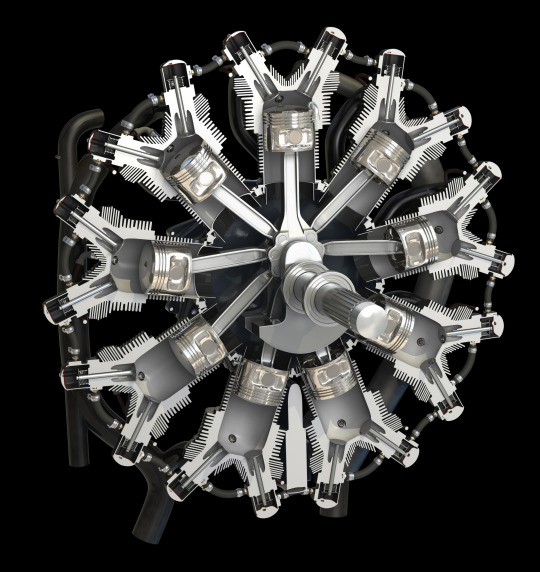#lycoming engine
Text

Took the 540 out for runs this morning. Since it was a prop strike inspection and we didn’t have to replace any piston rings or cylinder components, I didn’t have to do a full break in run, which is 90 minutes at varying power intervals. This run up was more focused on getting her up to temperature and making sure she made full power with no leaks, so I got away with less than an hour on the stand. Post run checks were positive with no abnormal metal contamination or other indications of issues. Another successful build, and she’s off to her owner in the next couple days.
10 notes
·
View notes
Text
Engine overhaul manual pdf
ual aviation
<br> lycoming io-360-l2a overhaul manuallycoming overhaul manual
<br> lycoming o-320 overhaul manual pdf
<br>
<br>
<br>
<br> </p><p> </p><p> </p><p>SERVICE MANUAL. APPLYING TO. THE FOLLOWING This manual contains a description of, and procedure for, dis- OVERHAUL OF ENGINE IN VEHICLE (Cont'd).
This overhaul manual is applicable to K Series engines fitted with either vvC or non vvC cylinder heads and damp cylinder liners. This engine is fitted
Page 77 (See following pages for details of each section) I¥ CONTINENTAL L-HEAD ENGINE MANUAL INDEX SECTION I E GENERAL INFORMATION FourCylinderL-HeadIN THIS OVERHAUL MANUAL. THIS OVERHAUL MANUAL, THE ENGINE OPERATOR'S MANUAL, AND ALL AP-. PLICABLE SERVICE BULLETINS AND INSTRUCTIONS ARE ISSUED iN COM-.
OVERHAUL MANUAL. TWTKOIY LYCOMING INTEGRAL ACCESSORY DRIVE AIRCRAFT. ENGINES. TO THE OWNER OF THIS MANUAL. IN ADDITION TO THIS MANUAL AND SUBSEQUENT
LYCOMING MODELS 0-320 AND 0-340 OVERHAUL MANUAL. WARRANTY. LYCOMING DIVISION - AVCO Manufacturing Corporation warrants each new engine to be free from
This overhaul manual is applicable to the 1.8 'K'. Series engine fitted to the Land Rover Freelander up to 2001 Model Year. Overhaul procedures for.
If the user of this manual is uncertain whether all current revisions have been incorporated into the manual, contact Teledyne Continental Motors. Do not
</p><br>https://nalugopoq.tumblr.com/post/693076249982205952/shimadzu-dgu-20a3-manual, https://huhehebiq.tumblr.com/post/693076717259177984/hioki-ft6031-earth-tester-manual, https://huhehebiq.tumblr.com/post/693076717259177984/hioki-ft6031-earth-tester-manual, https://nalugopoq.tumblr.com/post/693076249982205952/shimadzu-dgu-20a3-manual, https://huhehebiq.tumblr.com/post/693076717259177984/hioki-ft6031-earth-tester-manual.
#http://vk.cc/c7jKeU#nofollow#_blank#<p> </p><p> </p><center>ENGINE OVERHAUL MANUAL PDF >> <strong><u><a href= rel= target=>DOW#<br> lycoming o-360 overhaul manual pdf#<br> lycoming io-360 overhaul manual#<br> superior vantage engine overhaul manual#<br> overhaul man
0 notes
Text
Day 2 (bonus!)
Hello! This is the weekend bonus for today, the segment where we look at vehicles that aren't automobiles!
Today, the Piper Archer II PA-28-181 aircraft.
I'll be honest I don't know much about aircraft but I wanted this series to be a bit more varied and interesting for everyone!
Find more info on the Piper Archer II PA-28-181 below.
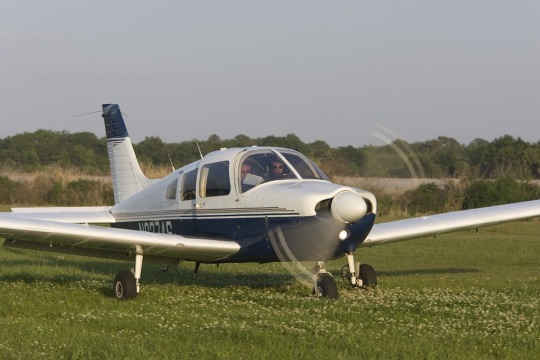
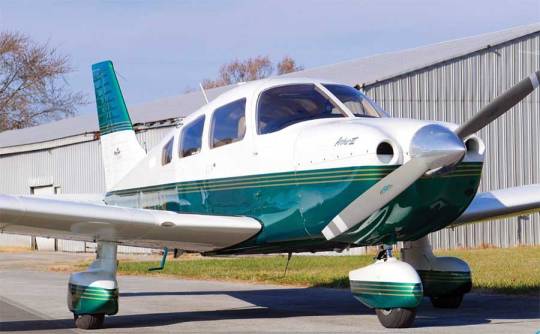
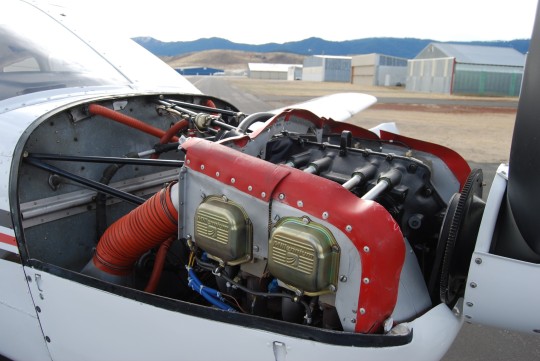

Date launched: May 22, 1972
Empty Weight: 1416 Lb
Company: Piper Aircraft
Exterior Height: 7 ft 3 in
Wing Span: 35 ft 5 in
Length: 24 ft 0 in
Max T/O Weight: 2550 Lb
Max Landing Weight: 2550 Lb
Payload Useful: 1134 Lb
Fuel Capacity: 48 gallons
Galph burned: 10 galph
Payload W/Full Fuel: 637 Lb
Engines: 1
Engine Mfg: Lycoming
Rate of Climb: 667 fpm
Max Speed: 125 kts
Normal Cruise: 116 kts
Economy Cruise: 110 kts
Occupancy: 1 crew, 4 passenger
Price: $119,000 USD
20 notes
·
View notes
Text

The Phantom Corsair
The Phantom Corsair was a marvel of futuristic design when it was shown publicly for the first time in 1938. The uniquely laid out body gave it seating for 6 but only 2 doors and 2 windows either side, giving it a beautiful, clean profile and leaving it still looking futuristic, even 70+ years later.
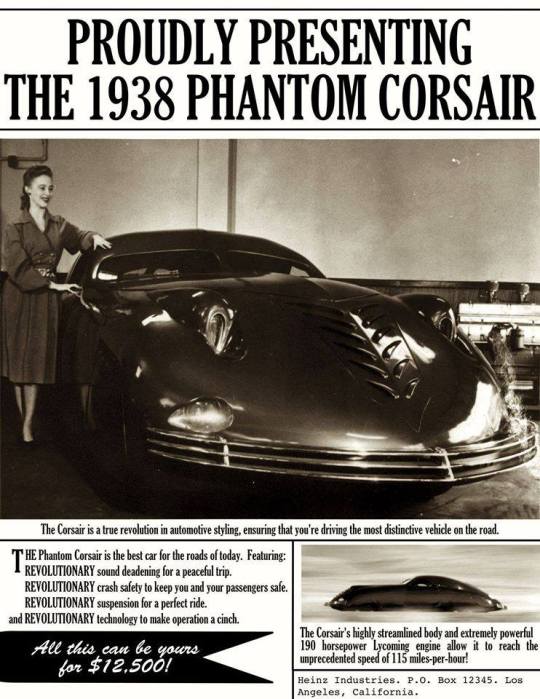
The Phantom was designed by Rust Heinz (of the H. J. Heinz family) and Maurice Schwartz of the California based Bohman & Schwartz coach building company. Heinz and Schwartz based the concept car on the Cord 810, possibly the most advanced chassis of the era, the Cord’s engine was a Lycoming 4.7L 8-cylinder unit, supercharged to produce 190 hp and was capable of propelling the Phantom Corsair to a top speed of 115mph.

The design of the car was revolutionary in the late 1930’s, the overall height of the car is just 58″ and there are no running boards, fenders or door handles. Interestingly, the lower part of the Phantom’s frame was welded chromoly steel and the upper frame was constructed of electrically welded aviation steel tubing, this helped keep the enormous car’s weight down to just 4500 lbs (2000 kg), that may not be feather weight but it would have been far higher with the more common all steel construction.

Sadly, the Phantom Corsair never made it into production, Heinz had planned a limited production run at an estimated selling price of $12,500 (1938 dollars), however he passed away shortly after the car was completed . It now lives in the National Automobile Museum (The Harrah Collection) in Reno, Nevada
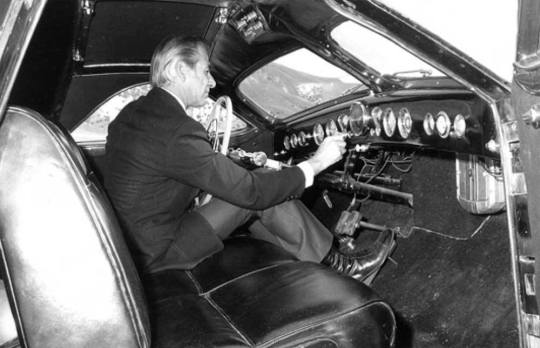





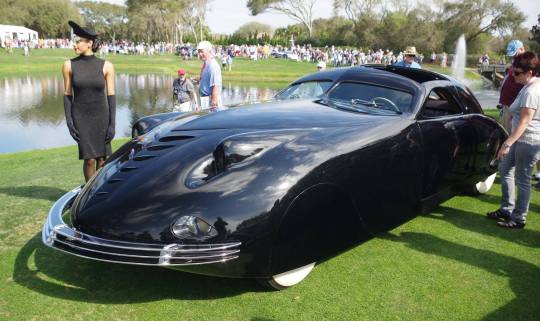

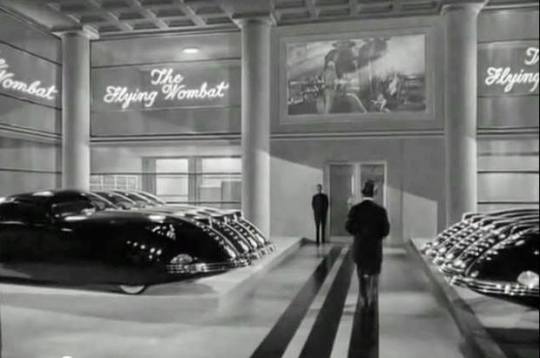
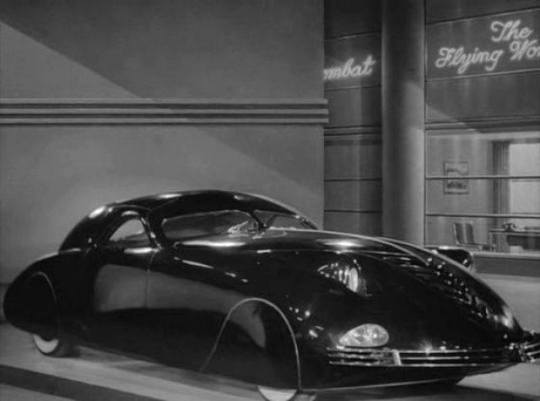
48 notes
·
View notes
Text
Look at the size of that engine! The massive 5,000 hp Lycoming XR-7755 first ran in 1946, and at 127 litres (7,750 cu in) is the largest piston aircraft engine ever built in the US. designed to power the next generation of large aircraft. However, it was never installed in an aircraft and was cancelled the same year.
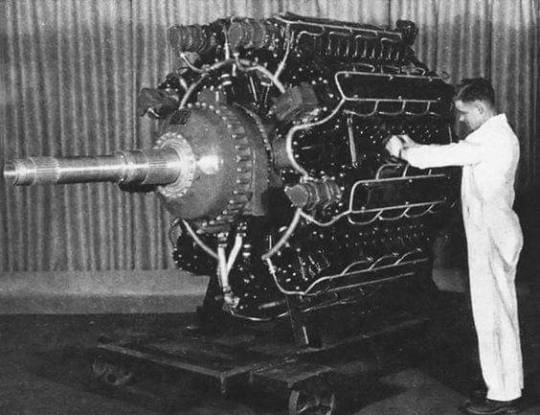
4 notes
·
View notes
Photo
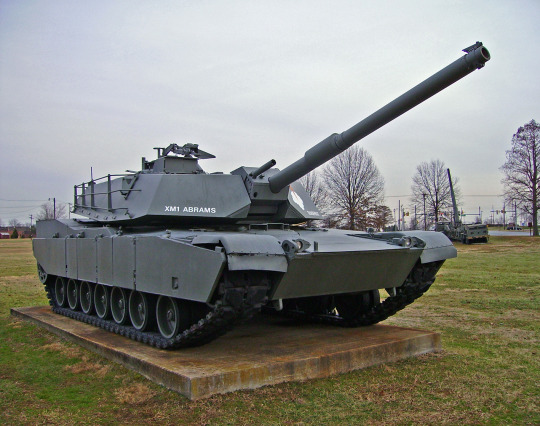
(via XM1 Abrams Main Battle Tank by DarkWizard83 on DeviantArt)
The original prototype vehicle that led to one of - if not the - most powerful tank in the world, and current backbone of Us armored forces, the M1 Abrams MBT. Born out of the failed German-American MBT-70 project, the XM1 was developed by the Chrysler Motor Corporation, and in 1978 Chrysler delivered to the Army a sleek, low-silhouette heavy tank that incorporated every major technological feature of the day, including computerized controls and a laser rangefinder.
But the most significant design feature of the new tank was its use of Chobham composite armor on the hull and turret. While the exact nature and composition of Chobham armor remains a closely guarded secret, the evidence suggests that it utilizes a matrix of ceramic armor tiles, layered between the vehicle's internal steel and external armored plating. When a high-velocity projectile - such as a round fired from a tank or an anti-tank missile - hits the armor, the explosion produces a high-velocity jet of gas that shears through the armor plating. In normal armor, this jet of gas - once it had passed through the outer armor - would blast into the hull of the tank, causing irreprible damage and often killing the crewmen inside. However, with Chobham armor's interweaved layers of ceramic composite, the forces that would normally tear into a tank's hull are forced to spread out and dissipate over a much wider area, leaving the inner hull intact. This not to say that Chobham armor renders a tank invincible - any hit will still cause exterior damage, and a powerfiul direct hit could still damage or disable the tracks or sensitive electronic equipment. But it would keep the crew alive, and often protect the tank itself enough to keep fighting.
Another key crew safety feature is the vault-like armored compartment that houses the Abrams' primary ammunition. One of the primary causes of a tank's destruction has not been the direct result of armor-pierecing hits, but the inderict results of those hits ignigting and detonating the tank's munitions. To protect this, a kevlar and steel armored plate seperates the crew from the ammunition store. Same with the tank's fuel supply. Even if the compartments were pierced, and the ammunition or fuel ignited, the protective plates would insulate the crew from explosion and fire.
In combat, the Abrams has proven to be second to none. During Operation Desert Storm in 1991, M1s were able to take out Iraqi tanks at distances as long as 4km. Of the nearly 2,000 Abrams to see combat in the conflict, only 18 were ever taken out of service due to combat damage, and none resulted in any crew casulties. In 2003 and onwards during Operation Iraqi Freedom, the Abrams again demonstrated a mastery of the battlefield, driving to Baghdad virtually unopposed. However, the Abrams clearly showed its vulnerability to ambush attacks, with a number of M1s severly damaged and disabled from RPGs, and far more frequently by roadside IED bomb traps. However, even when caught in some of the largest IED explosions, crew casualties have so far been astoundingly low, a testament to the M1s protection and survivability.
While no future M1's are planned for production, a number of older models are currently slated for upgrade to current standards over the next few years, and the Abrams will continue to serve with the Us Army and Marine Corps. for mcuh of the century to come.
M1 Abrams Vehicle Stats:
Type: Main battle tank
Manufacturer: General Dynamics Land Systems
First deployed: 1980
Crew: 4
Length: 9.76 m
Width: 3.65 m
Height: 2.88 m
Weight: 61.4 tons
Armor: Classified
Armament, primary: 1 x 105mm M68 rifled tank gun; later models equipped with 120mm M256 smoothbore tank gun
Armament, secondary: 2 x 7.62mm FN-Browning M240 machineguns, 1 x .50-cal Browning M2 BMG machinegun
Ammo stowage, primary: 55 rounds
Ammo stowage, secondary: 11,000 rounds 7.62mm, 1,000 rounds .50-cal
Powerplant: Textron Lycoming AGT1500 1,500hp gas-turbine engine
Max speed: 72 km/h
Max range: 498km
Operators: Australia, Egypt, Kuwait, Saudi Arabia, USA
13 notes
·
View notes
Text
This is the Lycoming AGT 1500, the engine used in the M1 Abrams tank
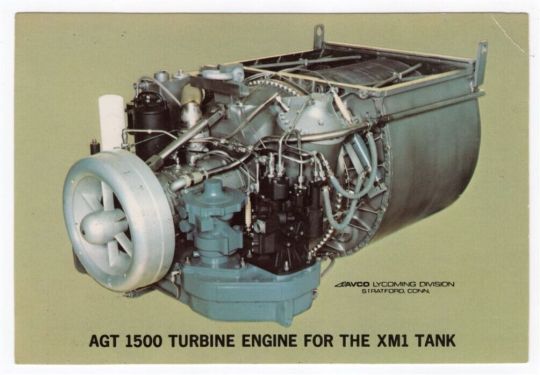
I think I'll name it "Thomas"
2 notes
·
View notes
Text
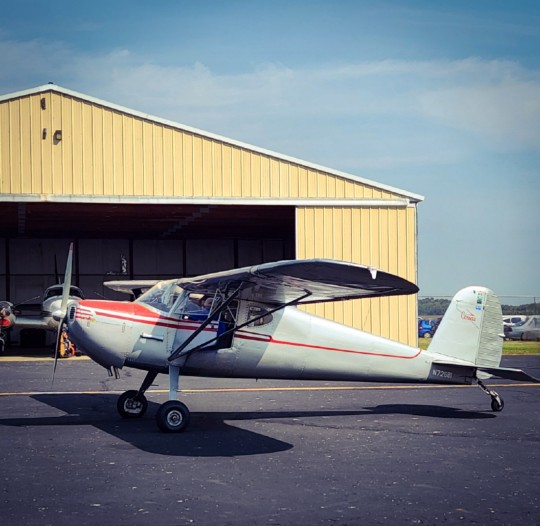
“Once you have tasted flight, you will forever walk the earth with your eyes turned skywards.”
— Leonardo Da Vinci
Remember what I always say, "everything tells a story... everything has bits of history."
This simple photo does not capture the beauty like a sunset. At first glance, there's nothing special about this 1946 Cessna 140; however, she holds something more beautiful... dreams!
On this gorgeous September morning, her 115 hp Lycoming 0-235 engine, carried over 100 kids on their first flight into the deep blue heaven above! We'll never know the impact of these flights... but the smiles of each child spoke of new beginnings! Dreams of the sky... and roar of engines!
Photo: Pickaway County Airport (KCYO), Circleville, Ohio. September 17, 2022.
#avgeek#aviation#vintage#airplane#young eagles#dreams#pilots#my photography#original photography on tumblr#my writing#cessna 140
30 notes
·
View notes
Text
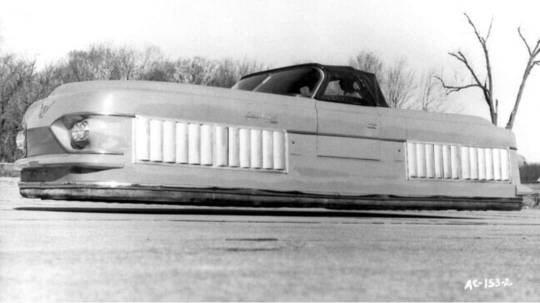
1959 Curtiss-Wright 2500 “Air Car”. Developed as a possible replacement for conventional cars, the Air Car was powered by dual Lycoming aircraft engines that operated a set of large fans on each side of the car.
This generated an air cushion of 10-15 inches and allowed the car to glide across terrain at a top speed of 38mph (61 kmh). Production was never realized and development ceased in 1961.
17 notes
·
View notes
Text


From dry fit for bearing measurements yesterday to fully closed and assembled today. I’m switching tracks this week from TCM engines back to a IO-540 Lycoming that had a prop strike. The work involved in the inspection and repair following a prop strike is usually as much as an overhaul. Everything must still be disassembled, inspected, and major components sent for NDT. The list of parts required might not be as long, depending on the situation, because the mandatory parts replacement of an overhaul isn’t normally applicable. Sometimes the damage is significant enough to warrant an overhaul for the sake of costs, but luckily for this customer that wasn’t the case.
9 notes
·
View notes
Text
How about some random ramblings about this odd yet cute twin engine plane I found on marketplace
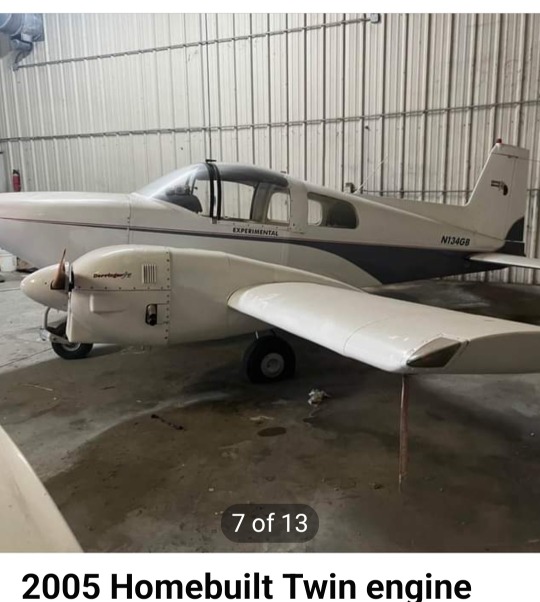
Yall know I'm all one for experimentals and homebuilts, they're decently affordable ways into the aviator's dream of owning a little airplane and some can be great trainers to gain more flight time/experience. I've flown in many different kinds of experimentals and homebuilts, I have one I'm rebuilding myself and will be flying regularly- but this is one very experimental airplane I don't think I'd be cool flying 😅
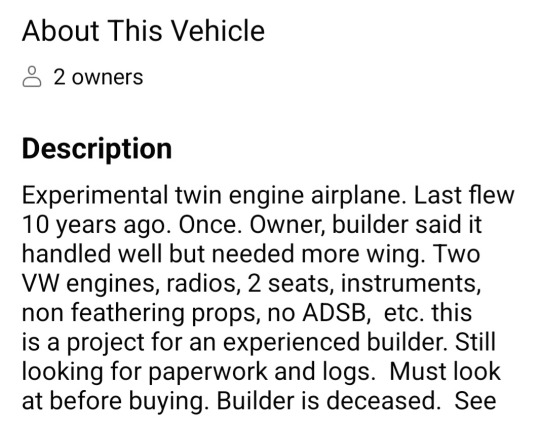
It's basically a mini version of a King Air powered by 2 VW engines- which is cool, there's thousands of little experimentals flying with VWs, engine is an engine and it's hardly different than a 4 cylinder Lycoming. My bird flew on a VW convert for about 2 decades before it blew up on the previous owner- & it'll keep flying on when I overhaul it. 😆
"Needs more wing area" which mean when one of those engines decides is quitting time at 9000 ft up, this thing's going to sink like a rock (hey just like a full scale King Air!) And guessing by the wood props, they can't feather.. Certain twin piston engine planes have a tendency to get into this weird barrel roll when they lose an engine.
Yah I love weird planes, but I'd much prefer to fly stuff with a decent glide ratio (unless it's some rare oddity and someone offers to take me up in it, I'll hop right in no questions asked 😆). I think I'd want this as a pet tho. It's so creacher. I'd keep it in a hangar, feed it Avgas, and drag it to airshows just to get people talking about it.
8 notes
·
View notes
Video
Navy N2S Stearman Kaydet by Willard Womack
Via Flickr:
Designed by Stearman but built by Boeing as Model 75. Those in the Navy were N2S dash 1,2,3,4 or 5, depending on the engine installed, with a total of 4,277 delivered. Those in the Air Force were, PT-13, PT-17, or PT-18 depending on the engine, with a total of 10,942 delivered. The engines used were the Lycoming R-680, (PT-13-- N2S-2, and 5.) The Continental R-670, (PT-17 -- N2S-1, 3,and 4. The Jacobs R-755, (PT-18 with only 150 built)
10 notes
·
View notes
Note
🌻
Embraer ERJ family
The Embraer ERJ family (for Embraer Regional Jet, model names EMB-135, EMB-140 and EMB-145) are regional jets produced by Brazilian aerospace company Embraer. The EMB145 was launched in 1989 as a turbofan-powered stretch of the EMB 120 Brasilia turboprop. It first flew on August 11, 1995, and it received its type certificate on December 10, 1996. The ERJ145 was introduced on April 6, 1997, and the shortened ERJ135 and ERJ140 were introduced in 1999.
Keeping the three-abreast seating of the Brasilia, the twinjet has a new swept wing and is powered by two rear-fuselage-mounted AE3007 turbofans for a range up to 2,000 nmi (3,700 km). The series includes the ERJ135 (37 passengers), ERJ140 (44 passengers), and ERJ145 (50 passengers), as well as the Legacy 600 business jet and the R-99 family of military aircraft. The family's primary competition came from the similarly sized Bombardier CRJ100/200 regional jets. Production ended in 2020 after 1,231 were built.
Development
The ERJ145 was designed for a perceived new market for regional jet aircraft, where the increased speed, comfort and passenger appeal would outweigh the inherent fuel economy of the turboprop aircraft which were in service and in development.[3]
Early design
The 45–48 seat EMB145 was launched at the Paris Air Show in 1989 as an 18 ft (5.5 m) stretch of the EMB 120 Brasilia developed for $150M plus $50M for training and marketing, one third the cost of the cancelled Short Brothers FJX project.[4] Its $11M unit cost would have been $3M less than the Canadair CRJ.[4] The 400 kn (740 km/h) jet would be powered by GE/Garrett CFE738s, Lycoming ALF 502s or Rolls-Royce plc/Allison Engine AB580s turbofans, to be selected in the summer of 1989.[4] It was targeted for a late 1992 introduction with six produced then ramping to 60 per year in 1995.[4] It aimed for half of a market for 1000 with break-even after twelve years with 400 sold.[4]
Keeping 75% of the Brasilia parts and systems, the EMB145 Amazon aimed for a 1991 first flight.[5] The stretch resulted from two 11 ft (3.4 m) plugs of the 7 ft 6 in (2.29 m) diameter fuselage in the front and behind the redesigned 538 sq ft (50.0 m2) wing.[5] Its supercritical airfoil with a 14% root thickness had its chord extended at the leading edge with a slight sweepback, increased aspect ratio and winglets.[5] The overwing podded engines generated 6,400 lbf (28 kN) of thrust.[5] Designed for 500–600 nmi (930–1,110 km) stages, up to 1,400 nmi (2,600 km) with a reduced payload, it had a 36,375 lb (16,500 kg) maximum takeoff weight (MTOW) and a 21,045 lb (9,546 kg) operating empty weight.[5]
Engine selection
In early 1990, no engine supplier willing to share the risk of the $250 million development was yet selected.[6] The Allison GMA3007 was selected in March 1990, with a maximum 40 kN (7,100 lbf) take-off thrust and growth capability to 45 kN (10,000 lbf), first flight was then due in September 1991.[7] Rolls-Royce could participate in the fan and low-pressure turbine, its original responsibility on the RB.580 joint development.[7] By May, it had 296 commitments from 19 operators, and was seeking external finance.[8] In June, maiden flight was expected by the end of 1990 before mid-1993 deliveries for $11.5 million each, cabin pressurisation was increased to 0.55 bar (8.0 psi) from the Brasilia 0.48 bar (7.0 psi).[9]
Following the engine selection, design was revised: length decreased from 27.08 to 26.74 m (88.8 to 87.7 ft), span increased from 22.37 to 22.49 m (73.4 to 73.8 ft), aspect ratio to 9.3 from 9.2.[10] MTOW rose from 16,500 to 18,500 kg (36,400 to 40,800 lb), basic operating weight from 9,560 to 10,940 kg (21,080 to 24,120 lb), maximum fuel from 3,900 to 4,210 kg (8,600 to 9,280 lb) and payload from 4,500 to 5,160 kg (9,920 to 11,380 lb).[10] wing loading increased from 330 to 370 kg/m2 (68 to 76 lb/sq ft), time-to-climb to FL400 gained 5 min to 30 min and maximum cruise rose from 405 kn (750 km/h) to 428 kn (787 km/h) at FL360.[10] First delivery in 1993 was slated to Comair, which ordered 60.[10] In November 1990, a major reduction in Brazilian government spending, which held 61% of its voting share, resulted in Embraer sacking 32% of its 12,800 employees and suspending development of the EMB-145 for six months.[11]
Revised design
In March 1991, a revised configuration started wind tunnel testing: the quarter chord wing sweep increased to 22.3° with underslung engines for lower aerodynamic drag. This reduced the span by almost 2 to 20.5 m (6 ft 7 in to 67 ft 3 in), reducing its aspect ratio from 9.3 to 8.4 and wing area from 50 to 47 m2 (540 to 510 sq ft). The semi-monocoque wing has two main and one auxiliary spar and holds 4,500 kg (9,900 lb) of fuel, it has double-slotted fowler flaps and spoilers. To accommodate the underwing engines, the landing gear is longer, allowing using jetways, and the fuselage was lengthened from 25.8 to 26 m (85 to 85 ft).[12]
In June 1991, the Brazilian Government loaned $600 million to Embraer and in July the programme was re-evaluated while tooling was 80% complete.[13] By November 1991, Embraer was still looking for partners to share the risk of the $350 million project, hoping to obtain Government approval by the end of the year.[13] Sold at $12 million with an all-digital cockpit and 31.8 kN (7,100 lbf) engines, it had letters of intent for 337 units.[13] First flight slipped to 1992 and certification for late 1993.[13]
Definitive design
After re-evaluation late in 1991, the layout was again revised with two rear-fuselage-mounted engines, and a Mach 0.8 cruise speed would be tested in the wind tunnel.[14] Seat pitch is 79 cm (31 in). A further stretch to 50–55 passengers is limited by a 12° rotation angle.[14] Embraer continued to look for partners to share the $350 million development as first flight was expected for late 1994.[14] In December 1994, Embraer was privatised for 80% to Brazilian and US investors while 20% was kept by the Brazilian Government.[15]
The definitive ERJ145 first flew on August 11, 1995, with 18 firm orders, 16 options and 127 letters of intent.[15] A 1,300h flight-test programme for the prototype and three pre-series aircraft (excluding two ground-test airframes) was planned within 13 months for certification in the third quarter of 1996, before deliveries in the fourth quarter of 1996 to launch customer Flight West.[15] The $14.5 million aircraft is developed with risk-sharing partners including Spain's Gamesa producing the wing; Chile's Enaer for the tail; and the USA's C&D Interiors equipping the cabin.[15] The standard maximum ramp weight is 19,300 and 20,300 kg (42,500 and 44,800 lb) for the extended-range, it is fitted with Honeywell Primus 1000 integrated avionics.[15]
The estimated $300 million development cost is divided between Embraer for 34%, risksharing partners for 33% (including Belgium's SONACA supplying centre and rear fuselage sections, doors, engine pylons and wing leading-edges), long-term loans from Brazilian development-funding institutions for 23% and participating suppliers for 10%.[16] On both 370 km (200 nm) hubfeeder and 1,100 km hub-bypass sectors, the EMB145 was expected to offer lower operating costs than the similarly priced Saab 2000 high-speed turboprop and the CRJ.[16] Its $15 million price was $4 million lower than the CRJ.[17]
The Flight Test campaign took four aircraft: S/N 801, PT-ZJA, S/N 001, PT-ZJB, S/N 002, PT-ZJC and S/N 003, PT-ZJD. Only S/N 003 was fitted with passenger seats and had no FTI (flight test instrumentation) and was used for functional and reliability tests.
In July 1996, its certification was targeted for October, unit cost was then US$15 million.[18] First delivery was planned for late November, 29 aircraft were to be produced in 1997, 38 in 1998 and at least 48 a year thereafter.[18] Its MTOW could be raised from the standard 19,200 to 20,600 kg (42,300 to 45,400 lb) for an Enhanced Range version.[18] Flight tests allowed to increase its cruise speed to Mach 0.78 from 0.74, and showed fuel economy was 7% better than predicted.[19] Before the Summer 1996 Farnborough Airshow, Embraer held 62 firm orders and 218 options.[20]Continental Express then purchased 25 EMB145s and took 175 options.[21] More than 50 seats would need a wider fuselage for four-abreast seating, an enlarged wing and a more powerful turbofan.[22]
It was approved by the FAA on December 10, 1996.[23]
Embraer delivered 892 units of all variants through 2006, and predicted that another 102 units would be delivered in the 2007–2016 time period.[24]
Production in China
In 2003, Embraer entered a partnership with the Harbin Aircraft Industry Group of Harbin, China. The resulting joint-venture company Harbin Embraer Aircraft Industry began producing the ERJ145 for the Chinese market by assembling complete knock down kits prepared by other worldwide Embraer operations. Last delivery was in March 2016; more than 40 ERJ145 and 5 Embraer Legacy 650 were assembled.[25]
Shortened versions
Embraer has introduced two shortened versions of the ERJ145. All three aircraft share the same crew type rating, allowing pilots to fly any of the three aircraft without the need for further training.
The ERJ140 is 1.42 metres (4.7 ft) shorter, seating 44 passengers, and has 96% parts commonality with the ERJ145. The only significant changes are a shorter fuselage, a slightly derated engine and an increased range. The ERJ140 was designed with fewer seats in order to meet the needs of some major United States airlines, which have an agreement with the pilots' union to limit the number of 50-seat aircraft that can be flown by their affiliates. At launch, Embraer estimated the cost of an ERJ140 to be approximately US $15.2 million. The estimated cost of development of the ERJ140 was US $45 million.
The ERJ135 is 3.54 metres (11.6 ft) shorter, seating 37 passengers, and has 95% parts commonality with the ERJ145. The first ERJ135 entered service in 1999.
Design
The airframe is mainly stretched, machined and chemically milled aluminium, with CFRP for moving parts, GFRP for fairings and sidewalls, kevlar for leading edges and Nomex honeycomb-CFRP/GFRP sandwiches for floors.[16]
Engine
The EMB145 family of aircraft generally comes equipped with two Rolls-Royce AE 3007 series turbofan engines. The engines have a bypass ratio of 5:1. The engines are controlled by two Full Authority Digital Engine Controls (FADEC). The FADECs control virtually all aspects of the engine and send engine data to be displayed on the EICAS for the pilot.
Avionics
The Embraer ERJ145 family of aircraft typically comes equipped with the Honeywell Primus 1000 avionics suite. The suite normally consists of five CRT display units (DUs) or screens. From left to right, the system consists of a Primary Flight Display (PFD), Multi-Function Display (MFD), Engine Indication and Crew Alerting System (EICAS), Multi-Function Display (MFD) (Co-pilot) and Primary Flight Display (PFD) (Co-pilot). The DUs are normally CRTs but can be upgraded to lighter LCD displays. These upgraded DUs also have added functionality.
Operational history
The first delivery was in December 1996 to ExpressJet Airlines (then the regional division of Continental Airlines flying as Continental Express). As of August 2021, the largest operatoris CommutAir which serves as United Express under United Airlines, with 165 ERJ145 aircraft.[26]
The ERJ140 was introduced in September 1999, first flew on June 27, 2000, and entered commercial service in July 2001. Envoy Air, the regional jet subsidiary of American Airlines flying as American Eagle, operated the majority of the ERJ140s built, including the first to be delivered (N800AE) but have since retired their ERJ140 fleet in mid-2020. As of early 2005, 74 ERJ 140s had been delivered. This version is marketed as ERJ140, but on the company's internal documents and on Federal Aviation Administration certification, the version is designated EMB 135KL. In March 2007 ExpressJet entered into a short-term agreement to operate some regional routes for JetBlue Airways using its ERJ145 aircraft.
In May 2017, the ERJ135 was leased $33,000 to $43,000 per month ($396,000 to $516,000 per year) and the ERJ145 $38,000 to $55,000 per month ($456,000 to $660,000 per year).[27]
As of 18 March 2018, the Embraer ERJ family was involved in 24 incidents for 8 hull losses without any fatalities.[28]
Variants
Civilian models
• ERJ135ER – Extended range, although this is the baseline 135 model. Simple shrink of the ERJ145, seating thirteen fewer passengers, for a total of 37 passengers.
• ERJ135LR – Long Range – increased fuel capacity and upgraded engines. Launch customer of Belgium Air Force.
• ERJ135KL
• ERJ140ER – Simple shrink of the ERJ145, seating six fewer passengers for a total of 44 passengers.
• ERJ140LR – Long Range (increased fuel capacity (5,187 kg) and upgraded engines. Launch customer of American Eagle. (Envoy)
• ERJ145STD – The baseline original, seating for a total of 50 passengers.
• ERJ145EU – Model optimized for the European market. Same fuel capacity as 145STD (4,174 kg) but an increased MTOW 19,990 kg
• ERJ145ER – Extended Range, although this is the Baseline 145 model.
• ERJ145EP – Same fuel capacity as 145ER (4,174 kg) but an increased MTOW 20,990 kg. Launch Customer of Flybmi.
• ERJ145LR – Long Range – increased fuel capacity (5,187 kg) and upgraded engines. Launch customer of CommutAir.
• ERJ145LU – Same fuel capacity as 145LR (5,187 kg) but an increased MTOW 21,990 kg.
• ERJ145MK – Same fuel capacity (4,174 kg), landing weight (MLW) and MTOW as in the 145STD, but a changed MZFW (17,700 kg).
• ERJ145XR – Extra-long Range, numerous aerodynamic improvements, including winglets, strakes, etc. for lower cruise-configuration drag; a ventral fuel tank (aft location) in addition to the two main larger capacity wing tanks (same tanks as in the LR models); increased weight capacity; higher top speed and up-rated engines. Launch customer of United Express.
• Legacy 600 (EMB135BJ) – Business jet variant based on the ERJ135.
• Legacy 650 (EMB135BJ) – Business jet variant based on the Legacy 600 with increased range.
• Harbin Embraer ERJ145 – joint venture with Harbin Aircraft Manufacturing Corporation.
The physical engines are the same (Rolls-Royce AE 3007), however, the FADEC (Full Authority Digital Engine/Electronic Control) logic is what differs between the various models in regards to total thrust capability.
The extended range version, the ERJ 145ER, has Rolls Royce AE 3007A engines rated at 31.3 kN(7,036 lb) thrust, with the option of more powerful AE 3007A1 engines. A, A1, A1P models are mechanically identical but differ in thrust due to variations in FADEC software. The A1E engine, however, has not only new software, but significantly upgraded mechanical components.
The long-range ERJ 145LR aircraft is equipped with Rolls Royce AE 3007A1 engines which provide 15% more power. The engines are flat rated at 33.1 kN (7,440 lb) thrust to provide improved climb characteristics and improved cruise performance in high ambient temperatures.
The extra-long-range ERJ 145XR aircraft is equipped with Rolls-Royce AE 3007A1E engines. The high performance engines provide lower specific fuel consumption (SFC) and improved performance in hot and high conditions. The engines also yield a higher altitude for one-engine-inoperable conditions."[29][unreliable source?] CommutAir is the only operator of the ERJ 145XR. February 2011 Embraer presented its new EMB-145 AEW&C for India.
Despite the multiple variants, pilots need only one type rating to fly any variant of the ERJ aircraft. Companies like American Eagle utilizes this benefit with its mixed fleet of ERJ135ER/LR and ERJ145EP/LR/XR. Shared type-ratings allow operators to utilize a single pilot pool for any ERJ aircraft.
Military models
• C-99A – Transport model
• EMB 145SA (R-99A) – Airborne Early Warning model
• EMB 145RS (R-99B) – Remote sensing model
• EMB 145MP/ASW (P-99) – Maritime patrol model
• EMB 145H (Hellenic Air Force) – Airborne Early Warning model
• EMB 145I (Indian Air Force) – Airborne Early Warning model
Civilian operators
As of October 2020, the main civilian operators
• Trans States Airlines: 30 Retired
• ExpressJet Airlines: 140 Launch customer
• Western Air : 7
• CommutAir: 30
• Envoy Air: 80 Launch customer of ERJ-140LR.
• Piedmont Airlines: 57
• Airlink: 28
• Loganair: 15
• Air Hamburg: 16
• JSX: 23
• Star Air (India): 5
• Belgium Air Force: 2 Launch customer of ERJ-135LR.
• Flybmi: 24 Launch customer of ERJ-145EP.
• Cronos airlines: 6
Military operators
🇦🇴 Angola
• Angolan Air Force
🇧🇪 Belgium
Belgian Air Component (operated two ERJ135 and two ERJ145 between 2001 and 2020 in passenger transport and VIP roles)
🇧🇷 Brazil
• Brazilian Air Force
• Brazil Federal Police
🇨🇴 Colombia
• Colombian Air Force
• SATENA
🇪🇨 Ecuador
• Ecuadorian Air Force
🇬🇷 Greece
• Hellenic Air Force
🇮🇳 India
• Indian Air Force (Operates 3 ERJ135 as VIP transport and ERJ145 as AEW&CS)
• Border Security Force
🇲🇽 Mexico
• Mexican Air Force
🇵🇦 Panama
• Panamanian Presidential Air Guard
🇹🇭 Thailand
• Royal Thai Army
• Royal Thai Navy[30]
Accidents
The ERJ-135/140/145 has been involved in 26 aviation accidents and incidents,[31] including 8 hull losses,[32] which resulted in zero fatalities.[33]
Hull losses accidents[32]
date | variant | operator | fat. | location | description
11 Feb 1998 | ERJ-135 | ExpressJet for Continental Express | 0 | USA, Beaumont-Jefferson County Airport | Crashed on takeoff during a training flight: the left wing stalled after the incorrect application of rudder during a V1 cut maneuver.[34]
28 Dec 1998 | ERJ-145ER | Rio Sul Serviços Aéreos Regionais | 0 | Brazil, Curitiba-Afonso Pena Airport | Too high descent rate and too fast landing, the tail cracked and was dragged along the runway.[35]
18 Jan 2003 | ERJ-135LR | American Eagle Airlines | 0 | USA, Columbus-Port Columbus International Airport
7 Dec 2009 | ERJ-135LR | SA Airlink | 0 | South Africa, George Airport | When landing in wet weather, the aircraft slid past the aerodrome's fence; the landing gear tyres had evidence of aquaplaning.
5 May 2010 | ERJ-145LR | SATENA | 0 | Colombia, Mitú-Fabio Alberto León Bentley Airport
25 Aug 2010 | ERJ-145LU | Passaredo Linhas Aéreas 0 Brazil, Vitória da Conquista Airport | Crash-landed on approach: touched-down short of the runway and stopped away from the runway.[36]
28 Apr 2011 | ERJ-145EP | Dniproavia | 0 | Russia, Moscow-Sheremetyevo Airport
4 Sep 2011 | ERJ-145LR | Trans States Airlines for United Express | 0 | Canada, Ottawa/Macdonald-Cartier International Airport | Slid off the runway upon landing.
4 Mar 2019 | ERJ-145XR | CommutAir for United Express | 0 | USA, Presque Isle International Airport | United Express Flight 4933 – pilots misidentified the runway in snow and did not abort the approach due to confirmation bias.[37]
11 Nov 2019 | ERJ-145LR | Envoy Air for American Eagle | 0 | United States, Chicago O’Hare International Airport | Slid off the runway upon landing in icy conditions.
Specifications
Variant ERJ135LR[38][39] | ERJ140LR[40][41] | ERJ145XR[42][43]
Crew 3 (2 pilots + flight attendant)
Length 26.34 m (86 ft 5 in) | 28.45 m (93 ft 4 in) | 29.87 m (98 ft 0 in)
Wing span 20.04 m (65 ft 9 in)
Wing 51.18 m2 (550.9 sq ft) area, aspect ratio 7.9, supercritical airfoil[44]
Height 6.76 m (22 ft 2 in)
MTOW 20,000 kg (44,092 lb) | 21,100 kg (46,517 lb) | 24,100 kg (53,131 lb)
BOW 11,501 kg / 25,355 lb | 11,808 kg / 26,032 lb | 12,591 kg / 27,758 lb
Max payload 4,499 kg (9,918 lb) | 5,292 kg (11,666 lb) | 5,909 kg (13,027 lb)
Fuel capacity LR: 4,499 kg (9,919 lb), XR: 5,973 kg (13,168 lb)
Engines (2x) AE 3007-A1/3 | AE 3007-A1/3 | AE 3007-A1E
Takeoff Thrust A1/3 : 33.71 kN / 7580 lbf; A1E: 39.67 kN / 8917 lbf[45]
Maximum cruise Mach 0.78 (450 kn; 833 km/h) / 145XR: Mach 0.8 (461 kn; 854 km/h)
Service ceiling 37,000 ft / 11,278m[a]
Range 1,750 nmi (3,240 km) | 1,650 nmi (3,060 km) | 2,000 nmi (3,700 km)
a. ^ 6,100 m (20,013 ft) on one engine[46]
Avionics[46]
• Primus 1000 colour weather radar
• Dual digital ADCs
• Dual AHRS
• TCAS and GPWS standard with FMS/GPS optional
• HUD for Cat III landing from 2000
See also
Related development
• Embraer EMB 120 Brasilia
• Embraer Legacy 600
• Embraer R-99 and P-99
Aircraft of comparable role, configuration, and era
• Bombardier CRJ100/200
• Fairchild Dornier 328JET
• VFW-Fokker 614
• Yakovlev Yak-40
• Embraer E-Jet family
Related lists
• List of jet airliners
• List of civil aircraft
References
1. ^ "Embraer delivers very last ERJ". aeroTELEGRAPH. 2020-07-06. Retrieved 2020-07-22.
2. ^ "Embraer ERJ-135 600/650, Embraer ERJ-145 production list". Rzjets.
3. ^ Resende, O.C. The evolution of the aerodynamic design tools and transport aircraft wings at Embraer, J. Braz. Soc. Mech. Sci. & Eng. vol.26 no.4 Rio de Janeiro Oct./Dec. 2004 Retrieved 8 November 2015.
4. ^ a b c d e "Embraer launches regional jet". Flight International. 24 June 1989. p. 6.
5. ^ a b c d e "Amazon lines up". Flight International. 1 July 1989. p. 19.
6. ^ "FAMA delays Embraer CBA-123". Flight International. 7 February 1990. p. 39.
7. ^ a b "Allison to power Embraer 145". Flight International. 14 March 1990.
8. ^ "Embraer sees EMB.145 options grow". Flight International. 2 May 1990. p. 14.
9. ^ a b c d "Regional aircraft directory". Flight International. 13 June 1990. p. 68.
10. ^ "Allison improves Embraer's 145". Flight International. 27 June 1990. p. 22.
11. ^ "Workforce cut as Embraer suspends EMB-145 plan". Flight International. 7 November 1990. p. 4.
12. ^ Guy Norris (27 March 1991). "Embraer tests new 145 as Vector takes to air". Flight International. p. 18.
13. ^ a b c d "Regional aircraft directory". Flight International. 6 November 1991. p. 44.
14. ^ a b c "Regional airliner directory". Flight International. 10 June 1992. p. 72.
15. ^ a b c d e "Embraer flies EMB-145". Flight International. 23 August 1995. p. 5.
16. ^ a b c Graham Warwick (18 October 1995). "Brazil's budget jet". Flight International. p. 59.
17. ^ Doug Cameron (21 August 1996). "Embraer claims US launch customer". Flight International. p. 6.
18. ^ a b c Peter Henley (3 July 1996). "Basic appeal". Flight International. p. 29. The EMB-145 is not an innovative aircraft, but Embraer's attention to basics makes it pleasant to fly."
19. ^ "Embraer increases EMB-145 cruise speed". Flight International. 10 July 1996. p. 3.
20. ^ Max Kingsley-Jones (28 August 1996). "Regional rivalry". Flight International. p. 90. The Embraer EMB-145's Farnborough debut will help to focus attention on regional airliners."
21. ^ "Continental lifts Embraer into regional record book". Flight International. 11 September 1996. p. 10.
22. ^ "Embraer evaluates next regional developments". Flight International. 18 September 1996. p. 14.
23. ^ "Type Certificate data sheet T00011AT" (PDF). FAA. September 28, 2015.
24. ^ "Embraer ERJ 135/140/145". Aviation Week & Space Technology. 29 October 2007. p. 66.
25. ^ Trautvetter, Chad (6 June 2016). "Embraer To Close Legacy 650 Assembly Facility in China". AINonline.
26. ^ "About us". CommutAir | Regional Airline. Retrieved 2021-08-06.
27. ^ Collateral Verifications LLC (May 2017). "myairlease FleetStatus". Archived from the original on 2017-09-12. Retrieved 2017-09-12.
28. ^ "Embraer 145 Statistics". ASN Aviation Safety Database. 18 March 2018.
29. ^ Aerospace-Technology.com ERJ145
30. ^ "Embraer Signs Contracts with the Royal Thai Army and the Royal Thai Navy" (Press release). São José dos Campos: Embraer. 5 November 2007. Retrieved 3 December 2008.
31. ^ "Accident list: Embraer ERJ-135/140/145". Flight Safety Foundation. 4 April 2019.
32. ^ a b "Embraer ERJ-135/140/145 hull losses". Flight Safety Foundation. 3 April 2019.
33. ^ "Embraer 145 Statistics". Flight Safety Foundation. 4 April 2019.
34. ^ "FTW98MA126: Full Narrative".
35. ^ Flight recorder video of Rio-Sul incident YouTube. Retrieved July 18, 2007.
36. ^ "Accident: Passaredo E145 at Vitoria da Conquista on Aug 25th 2010, landed short of runway". The Aviation Herald. 26 August 2010. Retrieved 28 August 2010
37. ^ National Transportation Safety Board Aviation Accident Final Report (Report). National Transportation Safety Board. 12 July 2022. DCA19FA089. Retrieved 20 July 2022.
38. ^ "E135 Weights" (PDF). Embraer. June 2013. Archived from the original (PDF) on 2014-11-29.
39. ^ "E135 Performance" (PDF). Embraer. June 2013. Archived from the original (PDF) on 2014-11-29.
40. ^ "E140 Weight" (PDF). Embraer. June 2013. Archived from the original (PDF) on 2014-11-29.
41. ^ "E140 Performance" (PDF). Embraer. June 2013. Archived from the original (PDF) on 2014-11-29.
42. ^ "E145 XR Weight" (PDF). Embraer. June 2013. Archived from the original (PDF) on 2014-11-29.
43. ^ "E145 XR Performance" (PDF). Embraer. June 2013. Archived from the original (PDF) on 2015-09-24.
44. ^ Lednicer, David. "The Incomplete Guide to Airfoil Usage". m-selig.ae.illinois.edu. Retrieved 16 April 2019.
45. ^ "Rolls-Royce AE3007" (PDF). type certificate data sheet. EASA. 5 May 2015.
46. ^ a b Jackson, Paul, ed. (2000). Jane's all the World's Aircraft 2000–01 (91st ed.). Coulsdon, Surrey, United Kingdom: Jane's Information Group. pp. 22–24. ISBN 978-0710620118.
Further Reading
• Official website
• Gerard Frawley. "Aircraft Technical Data & Specifications > Embraer ERJ-145". The International Directory of Civil Aircraft – via Airliners.net.
• "The accident involving the aircraft ERJ-145, Registration PT-SPE" (Press release). Civil Aviation Department of Brazil. 22 January 1999. Archived from the original on 9 February 2005.
• Endres, Gunter and Gething, Mike (2002). Aircraft Recognition Guide (2nd ed.). New York: Harper Collins. ISBN 0-00-713721-4.
• China Southern Airlines, Embraer China (June 29, 2004). "China Southern Takes Delivery of Two ERJ 145 Regional Jets; Built in China, the Embraer Aircraft Joins China's Largest Fleet" (Press release).
• "Commercial transport update - Status of programs". Aviation Week & Space Technology. 29 October 2007. pp. 63–66.
• Embraer (22 February 2011). "Embraer unveils the first EMB-145 AEW&C for the Indian Government" (Press release).
3 notes
·
View notes
Photo
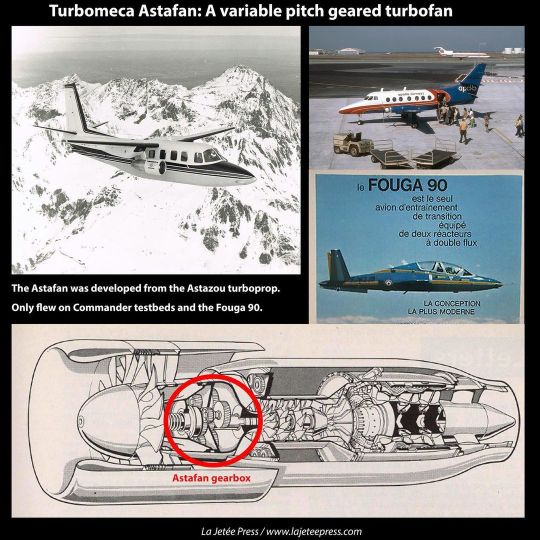
Before we move on in our survey of geared turbofans that will bring us to the Lycoming ALF 502 of the BAe-146 and the new PW1000G, let’s take a side trip from the Turbomeca Aubsique engine to another Turbomeca geared turbofan that did not reach production, the Astafan. I previously posted that the canceled Aerospatiale A.904 STOL airliner was to use a variable pitch geared turbofan called the M45SD that was based on the M45 engine used on the VFW614 airliner. A variable pitch front fan is exceedingly rare in jet engine technology- the M45SD was bench tested but never flew. But the Astafan did fly. On two different aircraft. The Astafan was based on the Astazou turboprop which was used on many aircraft of the 1960s and 1970s but most notably on the early versions of the Handley Page (later BAe) Jetstream. The Astazou first flew in 1957 and was used in both turboprop and turboshaft applications. It was easy to fit a gearbox to the Astazou core sized for the variable pitch front fan to create the Astafan. On the lower schematic, I’ve highlighted the location of the Astafan’s gearbox. Turbomeca tested the engine on two Rockwell Twin Commanders that had the piston engines removed but fairings for the main landing gears. The Astafan engines were slung underwing from pylons. Compared to turbojets of similar size, the Astafan was quieter and more fuel efficient. It first ran in 1969 but never reached production. The machinery for both the front fan gearbox and the variable pitch fan made the engine heavier than comparable designs and there were concerns about the complexity of maintenance. The only other aircraft to fly with the Astafan was the Fouga 90 which was planned as a modern successor to the Magister jet trainer. First flying in 1978, the Alpha Jet was selected instead of the Fouga 90 for the Armee de l’Air’s jet training requirements. Only a single Fouga 90 was built. (Jetstream photo: Richard Silagi) #avgeek #aviation #aircraft #planeporn #LaJeteePress #Turbomeca #Astafan #Astazou #turboprop #Jetstream #Aerospatiale #Fouga #Safran #instaaviation #aviationlovers #flight #AvGeekSchoolofKnowledge #AvGeekNation #TeamAvGeek https://www.instagram.com/p/Cfre_oiuOyP/?igshid=NGJjMDIxMWI=
#avgeek#aviation#aircraft#planeporn#lajeteepress#turbomeca#astafan#astazou#turboprop#jetstream#aerospatiale#fouga#safran#instaaviation#aviationlovers#flight#avgeekschoolofknowledge#avgeeknation#teamavgeek
2 notes
·
View notes
Text
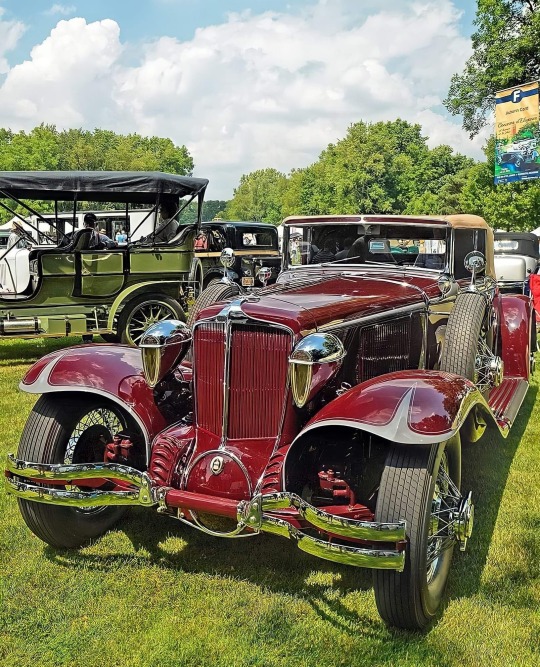
Arguably the finest 1931Cord L-29 Convertible in the world!
The Cord L-29 was one of those gentle leaders. The first major American car to offer front-wheel drive to the public, it came at a time of conservatism in automotive engineering, further deadened by the crushing weight of the Great Depression. Nonetheless, its engineering proved a starting point for those who followed, and who, inspired by it, worked until front-wheel drive was the mass success that it is today. If success is measured not in years of production or volume produced, but, like leadership, in the amount of influence it had on those who followed, the L-29 was the first successful American front-drive production car.
The Cord Front Drive (as the factory always called it) was the namesake of E.L. Cord, who was scarcely 35 when the first examples began rolling out of his Auburn Automobile Company in Auburn, Indiana. Its development was credited to the talented engineer Cornelius Van Ranst, working using some of Indianapolis legend Harry Miller's front-drive patents, and Auburn Chief Engineer Herbert Snow.
Essentially and simplistically, the idea was to take a rear-wheel drive car and turn everything around. It began with the chassis, which featured an innovative central X-brace to provide extra rigidity and rode on newly designed suspension, designed by Van Ranst and based on de Dion ideas. Brakes were moved inboard, as on the Miller Indy cars. On this rather sophisticated chassis rode a Lycoming straight eight, another fine Cord Corporation product, and it displaced 298 cubic inches and produced 125 horsepower. The engine was reversed so that the crankshaft exited the block at the front of the car and met a three-speed transmission that sat between the front wheels. The relocation of the transmission to the front of the car required an ingeniously long shift lever that extended from the L-29's dashboard down the length of the engine compartment and ended at the gearbox.
All this was wrapped in Alan Leamy's beautiful coachwork, which was outstanding for its refreshingly simple beauty. The Cord's innovative chassis engineering allowed it to stand only five feet tall. Leamy emphasized the lowness with clean, classic lines; long, flowing fenders; a simple radiator shell, painted to blend into the body; and wide beltline moldings that encouraged the use of factory-suggested two-tone color schemes. The interior boasted wide, comfortable seats, facing a fully instrumented dashboard with the distinctive dogleg shifter handle.
The Cord was mechanically genius and stylistically gorgeous. In the Great Depression, genius and beauty oft went unnoticed in favor of more practical matters. Production of the L-29 began in Auburn in late-1929 and wound up in late-1931 with a token run of 1932 models. Only about 5,000 had been made.
This cabriolet is one of the survivors. Certified and authenticated by the Auburn #Cord Duesenberg Club as being an original L-29 #Cabriolet, its history includes long-term California ownership by enthusiasts Ernie Mendicki, Bob Morehouse, and William "Chip" Connor. Connor, a noted collector whose cars have won Best of Show at the Pebble Beach Concours d'Elegance, acquired this car in 1983, and following its restoration, it was an award-winner in the special L-29 class at Pebble Beach in 1987. ( Sold for $407,000 )
https://www.facebook.com/545726305927325/posts/692415664591721/
0 notes
